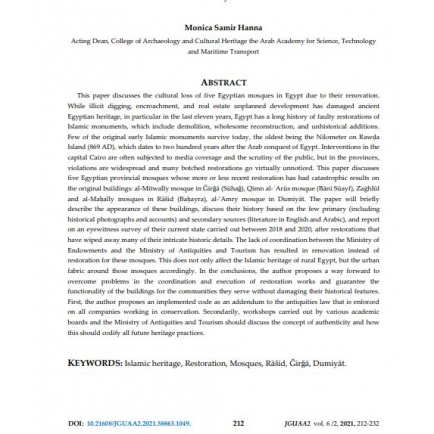
NOTE ON THE RESTORATION OF FIVE EGYPTIAN MOSQUES
تاريخ الاضافة
20/07/2022
نوع المحتوى
Documentary
Category
Researches
الرابط للمحتوى
Subject Area
Mosques
الكاتب
Monica Hanna
الناشر
Journal of the General Union of Arab Archaeologists
Year of Publication
2020
الوصف
This paper discusses the cultural loss of five Egyptian mosques in Egypt due to their renovation.
While illicit digging, encroachment, and real estate unplanned development has damaged ancient
Egyptian heritage, in particular in the last eleven years, Egypt has a long history of faulty restorations of
Islamic monuments, which include demolition, wholesome reconstruction, and unhistorical additions.
Few of the original early Islamic monuments survive today, the oldest being the Nilometer on Rawḍa
Island (869 AD), which dates to two hundred years after the Arab conquest of Egypt. Interventions in the
capital Cairo are often subjected to media coverage and the scrutiny of the public, but in the provinces,
violations are widespread and many botched restorations go virtually unnoticed. This paper discusses
five Egyptian provincial mosques whose more or less recent restoration has had catastrophic results on
the original buildings: al-Mitwally mosque in Ğirǧā (Sūhaǧ), Qimn al-ʿArūs mosque (Bāni Sūayf), Zaġhlūl
and al-Maḥally mosques in Rāšid (Baḥayra), al-‘Amry mosque in Dumiyāt. The paper will briefly
describe the appearance of these buildings, discuss their history based on the few primary (including
historical photographs and accounts) and secondary sources (literature in English and Arabic), and report
on an eyewitness survey of their current state carried out between 2018 and 2020, after restorations that
have wiped away many of their intricate historic details. The lack of coordination between the Ministry of
Endowments and the Ministry of Antiquities and Tourism has resulted in renovation instead of
restoration for these mosques. This does not only affect the Islamic heritage of rural Egypt, but the urban
fabric around those mosques accordingly. In the conclusions, the author proposes a way forward to
overcome problems in the coordination and execution of restoration works and guarantee the
functionality of the buildings for the communities they serve without damaging their historical features.
First, the author proposes an implemented code as an addendum to the antiquities law that is enforced
on all companies working in conservation. Secondarily, workshops carried out by various academic
boards and the Ministry of Antiquities and Tourism should discuss the concept of authenticity and how
this should codify all future heritage practices.





